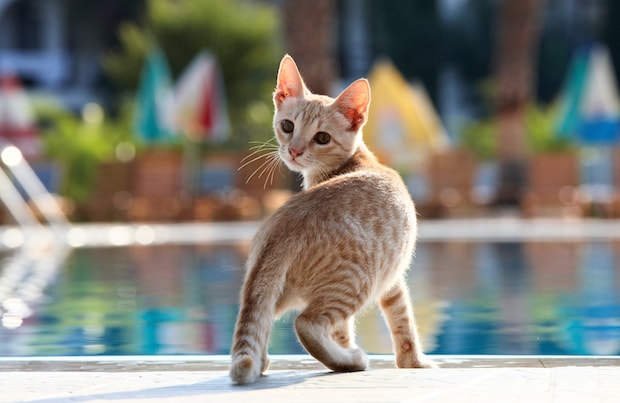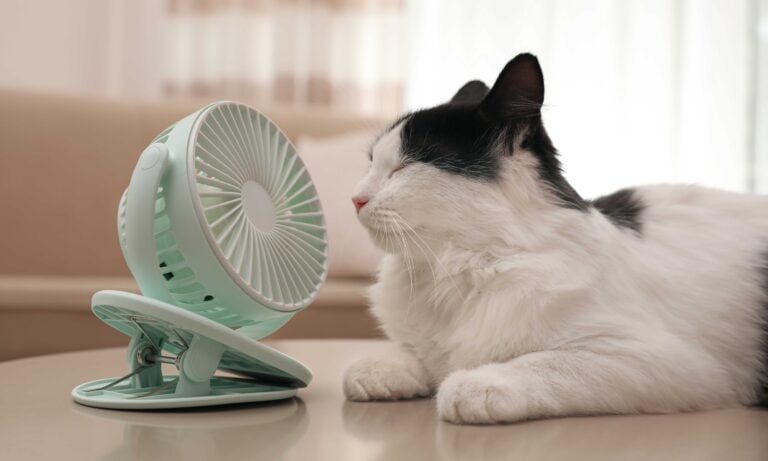Although most cats don’t like water, pool safety is still an important part of keeping your kitty safe. Here are a few pointers for making sure your feline pet stays out of danger.
Teach Her to Swim
Granted, not all cats will even get in the water, much less want to swim. But teaching your cat how to handle herself once in the pool could save her life as well as give her a fun new thing to do. The principles of kitty swim lessons are based on a very slow introduction to the water in the safety of your arms (wearing a long-sleeved wetsuit and gloves is a good idea) and gradually letting her instinct take over until she’s swimming on her own. Patience is key in feline swim school.
Help Her Out
Getting into the pool is easier for pets than getting out. Kitty’s soaked fur makes her heavier, and the reverse buoyancy of the water upon her exit makes it difficult to get out. If your cat is a pool lover, consider installing aSkamper Ramp to help her get out after she’s done splashing around. These devices are specially designed to assist four-legged friends in climbing out of a body of water.
Dry Out Her Ears
Competitive swimmers know that swimmer’s ear, an infection caused by residual pool water leading to bacterial growth in the outer ear canal, is quite painful and slow to heal. Cats can be vulnerable to ear infections as well if thorough drying after immersion is neglected. Use as many soft cotton balls as necessary to gently soak up any leftover moisture in kitty’s ears after she takes a dip. Dr. Billy Griswold of Priority Pet Hospital in Gilbert, Ariz., says a drying ear cleanser is quite effective as well.
Beware of the Pool Chemicals
While a short dip probably won’t hurt your pet, chlorine and other pool chemicals are best kept away from kitty’s sensitive skin and delicate inner system. Keep your feline from drinking the pool water by keeping a bowl of fresh water in a shady poolside spot. Once she’s finished with her refreshing dip in the pool, rinse her off thoroughly to remove any residual chemicals in her fur. Finish off with a brisk towel rub, a treat, and a cozy corner so she can enjoy an after-swim nap.
Get an Alarm
For non-swimming kitties, prevention can be your best ally in keeping your cat safe around your swimming pool. Griswold recommends that pet parents invest in a water-detecting collar that comes with a remote alarm speaker. When the sensor gets wet, the alarm sounds a danger alert. Other alarms that are made to detect disturbances to the water’s surface are more sensitive to wind and can sound too many false calls, thus are not recommended.
Strap on a Life Vest
Flotation devices and life jackets for kitty can make a hot day hotter, but they also let her get in on the splashing fun while ensuring she stays afloat. Life vests should only be used when your cat is being monitored with parental supervision. Keep a close eye on her while decked out in her life-saving garb to immediately detect signs of over-heating: panting, drooling, restlessly pacing to seek a cool spot, sweaty feet, and excessive grooming in an effort to make herself cooler.
Learn Kitty CPR
Knowing how to resuscitate your cat after an accidental jump into the water can mean the difference between life and death. Pet CPR and first aid courses prepare pet parents to provide life-saving techniques in those few precious minutes following an accident. No matter how close your veterinarian is to your home, the travel time may be too long for your furry friend. Interested students can take classes either in-person or online for a nominal fee to ensure they’re prepared for pet accidents, but Griswold recommends hands-on classes.
Whether your cat takes to the water or not, these simple tips should help everyone—including your cat—have fun around the pool.
Image via Shutterstock
Valerie Trumps
Share:









